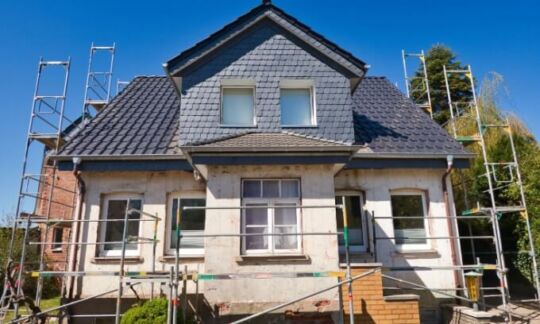Renovation Loans: How to finance your home renovations
Aussies love home improvement projects, and renovation loans help many of them to create their dream property. So how does renovation lending work and how can it help you finance your own home improvement project?

Aussies love home improvement projects, and renovation loans help many of them to create their dream property. So how does renovation lending work and how can it help you finance your own home improvement project?
Renovating is big business in Australia, with Aussies spending over 2.8 billion dollars on alterations and additions to their homes in the June 2024 quarter, according to the Australian Bureau of Statistics (ABS). There’s no doubt that a well-planned, quality renovation can potentially add to your home’s value.
The catch is that home improvements don’t always come cheap. According to Master Builders Australia’s The Future of the Workforce report, Australia continues to experience a shortage of skilled tradespeople in the building and construction industry. This shortage, coupled with rising material costs, means it could be more expensive than usual to renovate your home. With these factors in mind, it’s important to carefully plan your renovation budget and how you might finance it.
What is a renovation loan?
Renovation loans provide finance to specifically fund a home improvement project. But renovation loans aren’t the only way to finance your renovation. There are other loan and finance options which can be used to help fund home improvements. Finding one that suits your circumstances the best can be a key step in turning your renovation dream into a reality.
How to finance your renovation
Before you decide which type of renovation loan works best for you, it’s worth considering the other options. Here are five possible ways to pay for renovations (and some don’t involve taking on debt at all).
1. Offset, redraw or savings: Pay out of your own pocket
To avoid taking on any extra forms of debt, a renovator may decide to forego a home renovation loan entirely and use funds from a savings account. They can also potentially withdraw money built up in a home loan’s offset account or redraw facility, or sell investments such as shares or property to fund the project.
Using your own money to finance renovations may be more straightforward and potentially less financially risky than borrowing money. Although this method isn’t possible for everyone, doing this could mean that you would be free to sit back and enjoy the fruits of your renovation work without having to worry about paying back any extra debt with associated interest.
Using savings to pay for renovations
If you’re planning on using savings to finance your renovations, it may be worth checking whether you would still be left with an ‘emergency fund’ after you’ve withdrawn the amount required for your renovations. Maintaining rainy day savings can potentially help you deal with any unexpected expenses that could pop up, like an insurance excess or a car service.
Using offset or home loan redraw to fund renovations
Offset accounts and redraw facilities are features provided by some home loans. Offset accounts allow borrowers to put money into their home loan (or an account linked to it) to help reduce the amount of interest payable on the loan. Redraw facilities, on the other hand, allow borrowers to make additional loan repayments outside of their regular ones. The extra funds associated with each of these loan features can typically be accessed by the homeowner when needed, subject to the lender’s terms and conditions (which can be found in the loan’s Product Disclosure Statement (PDS)).
If you’re considering accessing money via an offset account or redraw facility, you may want to check the effect this could have on your home loan in the long run. Money saved in an offset account reduces the interest you’re liable to pay on top of the loan’s principal. So, reducing the amount being offset against your home loan could mean that you end up paying more overall and any time shaved off your loan term by the reduction in interest would be lost.
Compare home loans with offset accounts
Cashing in investments
Selling investments to pay for a renovation requires careful consideration, as investment markets can fluctuate without warning. There can also be tax implications if you are selling an investment that involves making a capital gain or profit. It could be a good idea to seek professional financial advice before making a decision.
2. Refinance your home loan
For those with enough equity built up in their property, refinancing could be an option to consider. Home equity is the difference between the value of your home and how much you still owe on your mortgage. Refinancing may allow you to leverage your equity to borrow the funds required to complete your renovations.
You could either re-negotiate your home loan with your lender to top up the amount of your existing loan or find another lender that is offering a better interest rate, features or terms and conditions. Some lenders also offer sign-up deals, often in the form of a cashback, for borrowers looking to refinance their home loan. It’s important to compare the interest rate, features and terms offered when weighing up whether a loan product’s sign-up deal is worth it.
It’s important to note that there can be fees and charges associated with refinancing a home loan, and the extra funds borrowed will impact your loan repayments or the time it’ll take to pay off your loan. You will most likely start paying interest on the additional money straight away. Keep in mind, it’s unusual to pay for big renovation projects in full before they’re completed.
One course of action could be to increase your loan size and place the renovation funds into a 100% offset account (assuming your home loan offers one). This would generally prevent you from having to pay any interest on the additional loaned amount until you need to use it.
Another option to consider could be to refinance with a line of credit home loan, which is designed to let you access funds as you need them, with interest charged on the balance owing on your account.
In some respects, refinancing is a similar commitment and process to taking out a new home loan, so make sure you consider the implications it could have on your wider finances. If you do decide to refinance, it can be worth shopping around for a competitive product.
3. Apply for a construction loan
If you’re embarking on a large renovation project such as an extension or a rebuild, you could consider a construction loan to finance your home renovations.
Construction loans are typically based on the estimated final (post-renovation) value of your property and will often release funds periodically throughout a renovation project’s timeline. This allows you to withdraw the amount needed to pay for renovation-related costs as they arise.
In some cases, construction loans can be interest-only for a period of time; in which case, they will generally revert to principal and interest repayments at a future date. This could be in addition to the existing mortgage on your home (known as a second mortgage), or you could refinance your existing home loan to be a construction loan.
4. Use a personal loan as a dedicated renovation loan
A personal loan can be a type of renovation loan used to fund home improvements. Personal loans typically allow you to borrow up to a maximum amount, often around $50,000 for unsecured loans and $100,000 for secured loans. Interest rates can vary widely depending on the loan product, the chosen terms, features and your credit score. You can check your credit score for free with Canstar or via the Canstar App.
Secured finance will, generally speaking, be cheaper than unsecured finance, as a secured loan has an asset attached to it as collateral. This means if you are unable to repay the loan, the lender can sell the listed asset to recoup the debt. Personal loans typically offer a range of options regarding assets that you can secure the loan against, such as term deposits, vehicles and property.
There are also specific green personal loans for homeowners looking to make environmentally friendly changes to their property, like installing roof insulation or solar panels.
Bear in mind that an interest rate which could be considered low for a personal loan product could still be relatively high when compared against a similarly competitive home loan interest rate. With this in mind, you may want to consider the pros and cons of a separate personal loan against refinancing your home loan.
Compare personal loans for renovations
5. Other home renovation loan options
If your renovation is likely to involve smaller, more regular expenses, then there are other types of finance that may be more suitable than a loan. For example, you could consider a credit card or overdraft facility attached to your everyday transaction account.
These options typically come with much higher interest rates and fees than other types of finance and may not be suitable for all renovations, particularly if you think you might not be able to repay the funds quickly. It could also be worth looking out for government grants or interest-free loans that may be available in your state or local area.
It can be important to read the relevant documentation, such as the Product Disclosure Statement (PDS) and Target Market Determination (TMD), for any loan product you are considering.
The comparison rate for all home loans and loans secured against real property are based on secured credit of $150,000 and a term of 25 years.
^WARNING: This comparison rate is true only for the examples given and may not include all fees and charges. Different terms, fees or other loan amounts might result in a different comparison rate.

Up to $4,000 when you take out a IMB home loan. Minimum loan amounts and LVR restrictions apply. Offer available until further notice. See provider website for full details. Exclusions, terms and conditions apply.
 Owner occupied
Owner occupied
 20% min deposit
20% min deposit
 Redraw facility
Redraw facility
 Owner occupied
Owner occupied
 10% min deposit
10% min deposit
 Redraw facility
Redraw facility
 Owner occupied
Owner occupied
 20% min deposit
20% min deposit
 Redraw facility
Redraw facility
 Owner occupied
Owner occupied
 20% min deposit
20% min deposit
 Redraw facility
Redraw facility
 Owner occupied
Owner occupied
 40% min deposit
40% min deposit
 Redraw facility
Redraw facility
 Owner occupied
Owner occupied
 40% min deposit
40% min deposit
 Redraw facility
Redraw facility
Canstar may earn a fee for referrals from its website tables, and from Sponsorship or Promotion of certain products. Fees payable by product providers for referrals and Sponsorship or Promotion may vary between providers, website position, and revenue model. Sponsorship or Promotion fees may be higher than referral fees. Sponsored or Promoted products are clearly disclosed as such on website pages. They may appear in a number of areas of the website such as in comparison tables, on hub pages and in articles. Sponsored or Promoted products may be displayed in a fixed position in a table, regardless of the product’s rating, price or other attributes. The table position of a Sponsored or Promoted product does not indicate any ranking or rating by Canstar. For more information please see How We Get Paid.
Additional reporting by Nick Whiting.
Cover image source: Photographee.eu/Shutterstock.com
This article was reviewed by our Finance Editor Jessica Pridmore before it was updated, as part of our fact-checking process.

The comparison rate for all home loans and loans secured against real property are based on secured credit of $150,000 and a term of 25 years.
^WARNING: This comparison rate is true only for the examples given and may not include all fees and charges. Different terms, fees or other loan amounts might result in a different comparison rate.
 Owner occupied
Owner occupied
 10% min deposit
10% min deposit
 Redraw facility
Redraw facility
Try our Home Loans comparison tool to instantly compare Canstar expert rated options.
The comparison rate for all home loans and loans secured against real property are based on secured credit of $150,000 and a term of 25 years.
^WARNING: This comparison rate is true only for the examples given and may not include all fees and charges. Different terms, fees or other loan amounts might result in a different comparison rate.






